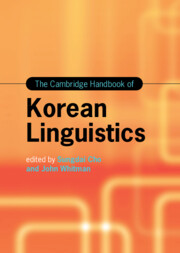Book contents
- The Cambridge Handbook of Korean Linguistics
- Cambridge Handbooks in Language and Linguistics
- The Cambridge Handbook of Korean Linguistics
- Copyright page
- Contents
- Figures
- Tables
- Contributors
- Preface
- Acknowledgments
- Abbreviations
- Part I Korean Overview
- Part II Phonetics and Phonology
- Chapter 7 Vowel Harmony
- Chapter 8 The Phonology and Phonetics of Korean Stop Laryngeal Contrasts
- Chapter 9 The Phonetics-Prosody Interface and Prosodic Strengthening in Korean
- Chapter 10 Constituent Structure and Sentence Phonology of Korean
- Chapter 11 Effects of Linguistic Experience on the Perception of Korean Stops
- Part III Morphology and Syntax
- Part IV Semantics and Pragmatics
- Part V Sociolinguistics and Psycholinguistics
- Part VI Language Pedagogy
- Index
- References
Chapter 10 - Constituent Structure and Sentence Phonology of Korean
from Part II - Phonetics and Phonology
Published online by Cambridge University Press: 30 September 2022
- The Cambridge Handbook of Korean Linguistics
- Cambridge Handbooks in Language and Linguistics
- The Cambridge Handbook of Korean Linguistics
- Copyright page
- Contents
- Figures
- Tables
- Contributors
- Preface
- Acknowledgments
- Abbreviations
- Part I Korean Overview
- Part II Phonetics and Phonology
- Chapter 7 Vowel Harmony
- Chapter 8 The Phonology and Phonetics of Korean Stop Laryngeal Contrasts
- Chapter 9 The Phonetics-Prosody Interface and Prosodic Strengthening in Korean
- Chapter 10 Constituent Structure and Sentence Phonology of Korean
- Chapter 11 Effects of Linguistic Experience on the Perception of Korean Stops
- Part III Morphology and Syntax
- Part IV Semantics and Pragmatics
- Part V Sociolinguistics and Psycholinguistics
- Part VI Language Pedagogy
- Index
- References
Summary
Chapter 10 continues with the discussion of prosodic phonology, but shifts the focus to the issue of how prosody relates to constituent structure in Korean. Korean is interesting because various segmental alternations are sensitive to different prosodic levels, thus providing a test case for prosodic phonology. Lenis stop voicing is a segmental alternation that correlates with the presence of a phonological phrase (Silva 1988; Cho 1990; inter alia). Moreover, intonation patterns coupled with segmental alternations supplant additional data for understanding prosodic structure in Korean. In Seoul Korean, an accentual phrase has been argued to have an LHLH accent; this unit also correlates with segmental alternations such as lenis stop voicing (Jun 1993). The sentence phonology of Korean offers insights into the general issue of the prosody-syntax interface and provides many kinds of evidence on how constituent structure affects the organization of sentence phonology. The chapter first reviews earlier research, then proposes a revised version of the general theory of the prosody-syntax interface.
Keywords
- Type
- Chapter
- Information
- The Cambridge Handbook of Korean Linguistics , pp. 294 - 317Publisher: Cambridge University PressPrint publication year: 2022

